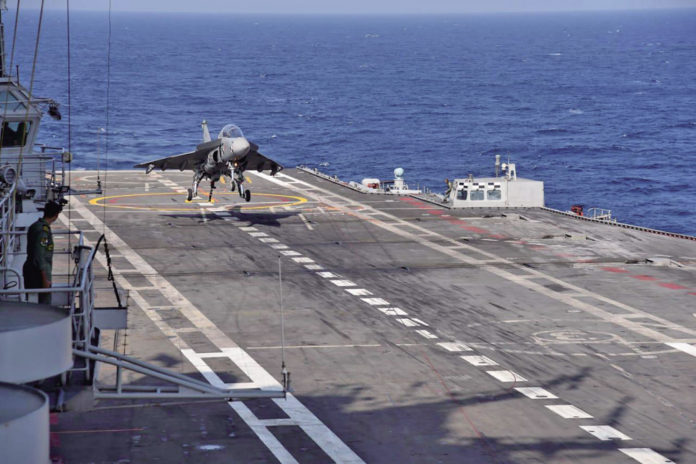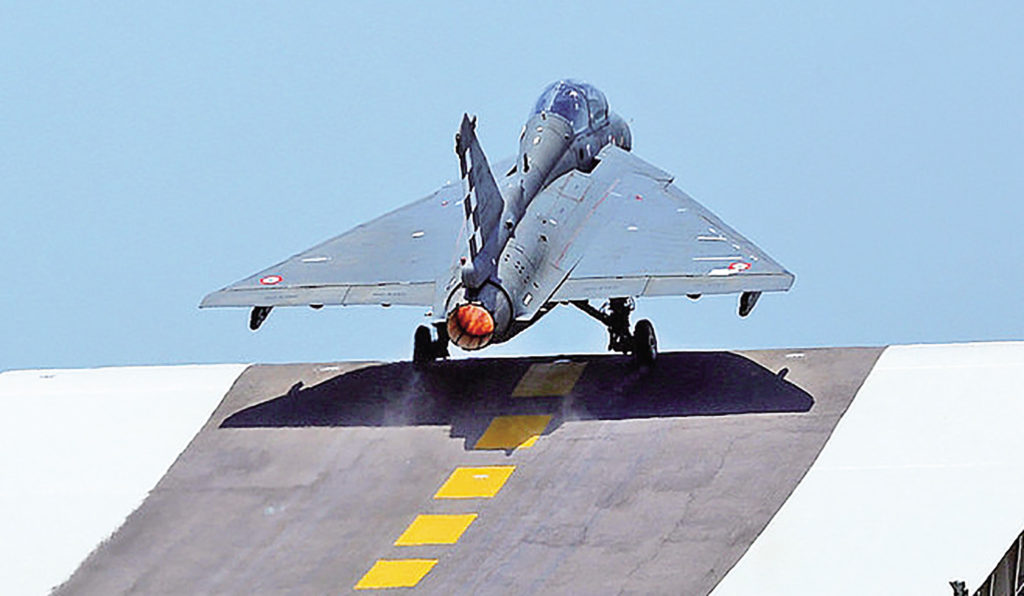
Tejas NP-2, one of the only two prototypes of the naval variant of the Tejas light combat aircraft (LCA), flown by Cmde Jaideep Maolankar, successfully conducted an “arrested landing” for the first time on the deck of aircraft carrier INS Vikramaditya, on 11 January, in a significant milestone for the indigenous fighter. The deck on the carrier is barely 200 metres long.
The same LCA also successfully took off from the from the “ski-jump” deck of the aircraft carrier for the first time next day. The ski-jump is the upwardly curved ramp on the deck of aircraft carriers designed to provide sufficient take-off lift for fighter jets.
Further landings and take-offs followed for a week. The second prototype, NP-1, piloted by Capt Shivnath Dahiya did a number of approaches, including a few Bolters (when a approaching aircraft misses the catching wire and get back airborne right away with full throttle).
The naval Tejas had earlier completed extensive trials on the shore-based test facility (SBTF) at Goa on 13 September. The Navy has created the SBTF as an aircraft carrier setting on the ground at its air base in Goa to operate these deck-based fighters, which use ski jump to take off and are recovered by arrestor wires on a carrier or STOBAR (short takeoff but arrested recovery) in navy parlance.
This was the first time an indigenous fighter, which has been designed and developed by DRDO, made arrested landing on an aircraft carrier in India.
Much more will be required for the naval Tejas prototype to become operational on the 44,400-tonne carrier INS Vikramaditya, as also the under-construction 40,000-tonne INS Vikrant. At present, the Navy operates 45 MiG-29K fighters, acquired from Russia for $2 billion, from INS Vikramaditya.

The Navy, in the past, has rejected the single-engine Tejas, stressing the “overweight” fighter cannot optimally operate from aircraft carriers. In December 2016, for instance, the then Navy chief Admiral Sunil Lanba had said it did not meet the “thrust-to-weight requirement to take off with a full fuel and arms load” from an aircraft carrier’s deck.
Only the US, the UK, Russia, France and China have built fighter jets that have carried out arrested landing on the deck of an aircraft carrier. Carrier strike groups help a country project maritime power thousands of miles away from its shores. Such groups are escorted by destroyers, frigates, submarines and supply vessels.
Difficulty in Landing
Landing on an aircraft carrier deck is the ultimate and most daunting challenge for a fighter pilot. He is required to slam down his fighter on a precise spot, so that the aircraft’s tail hook catches on a series of three wires laid across the landing deck. These wires unspool under resistance, dragging the fighter to a halt. Catching this so-called “arrestor gear” requires the fighter to descend much more sharply than in a regular landing. That requires a sturdy landing gear that can withstand the impact of what naval pilots often describe as a “controlled crash”.
To complicate matters further, the pilot approaching the carrier at at 230 km per hour is required to land with the throttle at “maximum power” so that, in case the tail hook does not catch the arrestor wires, the fighter can accelerate to take-off speed in the 200 metres of deck available to him.
The plane was carrying a full load of fuel so as to allow the pilot to land back at naval air station in Goa in case the landing on deck was to be aborted.
Carrier deck landings and take-offs can be greatly assisted by well-tuned flight computers.
Twin-Engined Naval Fighter
With this feat, the indigenously developed niche technologies specific to deck-based fighter operations have been proven. These will pave the way to develop and manufacture the twin-engine deck-based fighter for the IndianNavy.
The single-engine LCA Navy Mark I that landed, on 12 January, will not be inducted into naval service, being short on power and, therefore, fuel and weapons carriage capacity. The Navy is waiting for a twin-engine LCA Navy Mark 2, with the engine power to get airborne with more fuel and weapons, which will provide greater punch and a longer operating range. The current Mark 1 is a test bed for developing the aviation systems that will go into the Mark 2.
The Aeronautical Development Agency (ADA) refers to the Mark 2 version as the Twin Engine Deck Based Fighter (TED-BF). ADA says it is targeting the first flight by 2025-26 and induction into service by 2031, when it will start to replace the Russian-origin MiG-29K/KUB fighters that currently fly off INS Vikramaditya.
With the current LCA Navy Mark 1’s single General Electric (GE) F-404 engine replaced by two, more powerful, GE F-414 engines, the TED-BF will be a bigger and more heavily armed fighter.
The ADA will now carry out more test landings on INS Vikramaditya to generate inputs to finetune the controlling software.
The Defence Research and Development Organisation (DRDO) is involved in development of the naval variant of Tejas along with ADA, Aircraft Research and Design Centre of Hindustan Aeronautics Ltd, Centre for Military Airworthiness and Certification (CEMILAC) and CSIR among others.
The Indian Air Force (IAF) has already inducted a batch of Tejas aircraft. Initially, the IAF had placed an order with the Hindustan Aeronautics Limited (HAL) for 40 Tejas aircraft.
In 2018, the IAF issued the request for proposal (RFP) to HAL for the procurement of another batch of 83 Tejas at a cost of over Rs 50,000 crore.
HAL’s Contribution
Hindustan Aeronautics Ltd eyes the prospect of fully designing and developing a twin-engine fighter plane for the Navy if or when an occasion comes up. HAL has been deeply involved in the deck trials of the two naval prototypes produced for the DRDO.
The DRDO’s special arm ADA or the ADA is tasked with designing and developing the Tejas versions and future indigenous fighter planes.
HAL said many critical paraphernalia and support staff for the naval prototype were its contributions, both before and during the recent trials on the ship. It contributed the arrestor hook system, a redesigned landing gear, a speed controlling device for landings, a drooped nose to give the pilot a good view, a stronger fuselage and the fuel dump.
The two Navy prototypes – NP1 and Np2 – seen as potential trainers, were derived from the IAF version of the indigenous light fighter. A production standard version called NP5 has also been considered.
All these are single-engine while the Navy indicated in 2016 that it needed only two-engined aircraft. With a double-engine Tejas being some time away, more so for the Navy, it is an area of interest for its stakeholders.
The current fleet of Russian origin MiG-29Ks are expected to go obsolete around 2028-32. Another opportunity to replenish naval aircraft could arise if the country goes in for a third aircraft carrier around the year 2040 as envisioned for the long term.

















